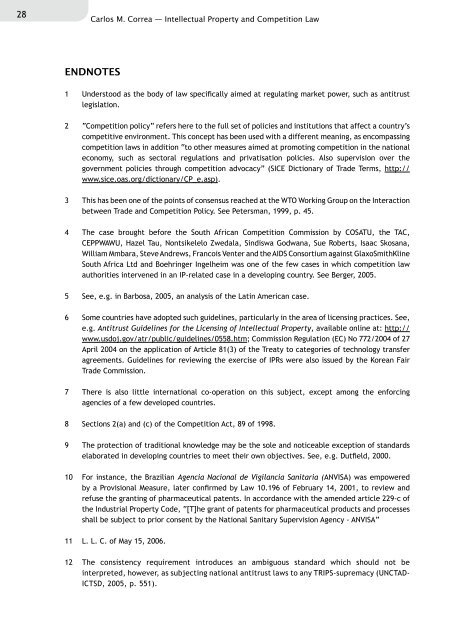Intellectual Property and Competition Law - IPRsonline.org
Intellectual Property and Competition Law - IPRsonline.org
Intellectual Property and Competition Law - IPRsonline.org
You also want an ePaper? Increase the reach of your titles
YUMPU automatically turns print PDFs into web optimized ePapers that Google loves.
28Carlos M. Correa — <strong>Intellectual</strong> <strong>Property</strong> <strong>and</strong> <strong>Competition</strong> <strong>Law</strong>Endnotes1 Understood as the body of law specifically aimed at regulating market power, such as antitrustlegislation.2 “<strong>Competition</strong> policy” refers here to the full set of policies <strong>and</strong> institutions that affect a country’scompetitive environment. This concept has been used with a different meaning, as encompassingcompetition laws in addition “to other measures aimed at promoting competition in the nationaleconomy, such as sectoral regulations <strong>and</strong> privatisation policies. Also supervision over thegovernment policies through competition advocacy” (SICE Dictionary of Trade Terms, http://www.sice.oas.<strong>org</strong>/dictionary/CP_e.asp).3 This has been one of the points of consensus reached at the WTO Working Group on the Interactionbetween Trade <strong>and</strong> <strong>Competition</strong> Policy. See Petersman, 1999, p. 45.4 The case brought before the South African <strong>Competition</strong> Commission by COSATU, the TAC,CEPPWAWU, Hazel Tau, Nontsikelelo Zwedala, Sindiswa Godwana, Sue Roberts, Isaac Skosana,William Mmbara, Steve Andrews, Francois Venter <strong>and</strong> the AIDS Consortium against GlaxoSmithKlineSouth Africa Ltd <strong>and</strong> Boehringer Ingelheim was one of the few cases in which competition lawauthorities intervened in an IP-related case in a developing country. See Berger, 2005.5 See, e.g. in Barbosa, 2005, an analysis of the Latin American case.6 Some countries have adopted such guidelines, particularly in the area of licensing practices. See,e.g. Antitrust Guidelines for the Licensing of <strong>Intellectual</strong> <strong>Property</strong>, available online at: http://www.usdoj.gov/atr/public/guidelines/0558.htm; Commission Regulation (EC) No 772/2004 of 27April 2004 on the application of Article 81(3) of the Treaty to categories of technology transferagreements. Guidelines for reviewing the exercise of IPRs were also issued by the Korean FairTrade Commission.7 There is also little international co-operation on this subject, except among the enforcingagencies of a few developed countries.8 Sections 2(a) <strong>and</strong> (c) of the <strong>Competition</strong> Act, 89 of 1998.9 The protection of traditional knowledge may be the sole <strong>and</strong> noticeable exception of st<strong>and</strong>ardselaborated in developing countries to meet their own objectives. See, e.g. Dutfield, 2000.10 For instance, the Brazilian Agencia Nacional de Vigilancia Sanitaria (ANVISA) was empoweredby a Provisional Measure, later confirmed by <strong>Law</strong> 10.196 of February 14, 2001, to review <strong>and</strong>refuse the granting of pharmaceutical patents. In accordance with the amended article 229-c ofthe Industrial <strong>Property</strong> Code, “[T]he grant of patents for pharmaceutical products <strong>and</strong> processesshall be subject to prior consent by the National Sanitary Supervision Agency - ANVISA”11 L. L. C. of May 15, 2006.12 The consistency requirement introduces an ambiguous st<strong>and</strong>ard which should not beinterpreted, however, as subjecting national antitrust laws to any TRIPS-supremacy (UNCTAD-ICTSD, 2005, p. 551).









